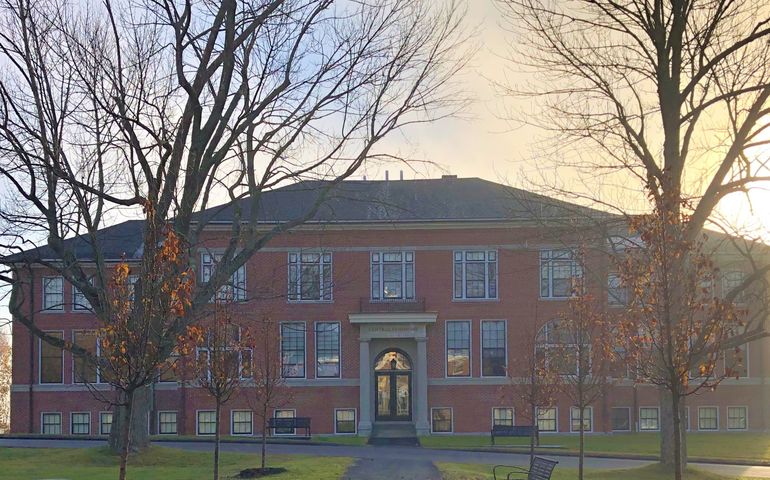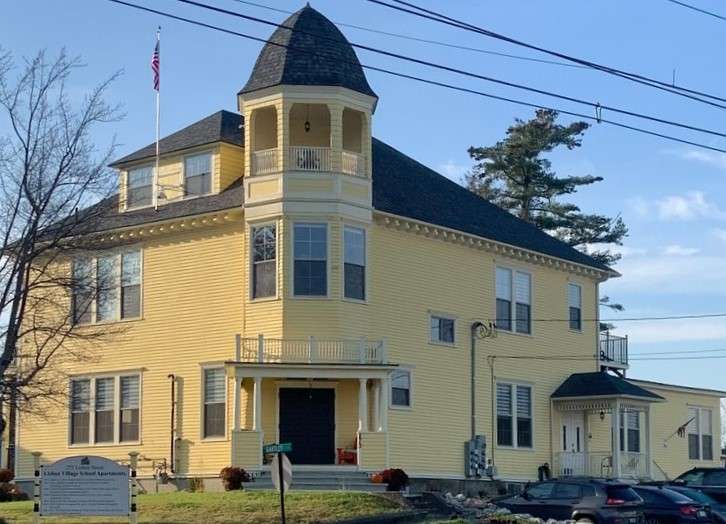
Processing Your Payment
Please do not leave this page until complete. This can take a few moments.
- News
-
Editions
View Digital Editions
Biweekly Issues
- December 1, 2025
- Nov. 17, 2025
- November 03, 2025
- October 20, 2025
- October 6, 2025
- September 22, 2025
- + More
Special Editions
- Lists
- Viewpoints
-
Our Events
Event Info
Award Honorees
- Calendar
- Biz Marketplace
Hallowell development adds 2 more buildings to Maine Preservation Honors list
 Photo / Maureen Milliken
The Central Building, at Stevens Common in Hallowell, is one of four buildings on the former state school for girls campus to receive a Maine Preservation Honor Award in the last three years.
Photo / Maureen Milliken
The Central Building, at Stevens Common in Hallowell, is one of four buildings on the former state school for girls campus to receive a Maine Preservation Honor Award in the last three years.
A complex that was once a run-down collection of mostly vacant 19th- and early 20th-century buildings in Hallowell is becoming the star of the Maine Preservation Honors Awards.
Two more buildings on the Stevens Commons campus, being developed by Mastway Development, of Hallowell, have been named to the 2020 honors list, Maine Preservation announced Monday. That brings to four the number of buildings at the former Stevens School for Girls site.
Developer Matt Morrill "has done a fantastic job of putting mixed uses in a variety of buildings," Greg Paxton, of Maine Preservation, told Mainebiz Tuesday morning. The Central and Erskine buildings, honored this year, join Stevens Hall and the Administration Building as Maine Preservation Honor Award winners.
"It's a real mix of uses in a little mini-village on top of the hill in Hallowell," Paxton said. Uses include University of Maine at Augusta residences, senior housing and office use.
"He really has great vision," Paxton said, of Morrill.
The Central and Erskine buildings on the campus are among 12 individuals and redeveloped buildings from Saco to Brooklin to be named to this year's list, which celebrates outstanding examples of historic preservation and revitalization statewide and recognize the owners, professionals, preservationists and partners who make them possible, the Yarmouth-based nonprofit says.
This year's winners will be celebrated at a virtual awards ceremony 5 p.m. Thursday, where the People's Choice Award, picked by the public, will also be announced.
“When completed, these buildings lift the economics of the areas around them and the spirits of the citizens benefitting from them," Paxton said in the news release announcing the winners. "These projects recall the history of their surrounds and our predecessors that built and used them, while filling current needs. And these well-built buildings can be feasibly rehabilitated, economically operated and energy efficient. Maine Preservation is pleased to recognize these people and projects and the many benefits to Maine they provide.”
For in-depth descriptions of this year's winners and what makes them special, vist the Maine Preservation website. This year's honorees are:

The Central and Erskine buildings, at the former Maine Industrial School for Girls, now Stevens Commons. The Erskine Building was completed in 1901 and the Central Building in 1917, both part of the nine-building, 63-acre campus on Winthrop Street in Hallowell that Mastway owner Matt Morrill bought in 2016 for $215,000.
The Erskine Building, which opened as the second University of Maine at Augusta dorm on the campus, is the sixth building to be renovated. It's being leased by UMA, and owned by Mastway. Mastway renoved the Central Building, which is owned by Community Housing of Maine.
The school for girls closed in 1970 and, after that, many of the buildings became state offices, which moved out in 2003. The campus was mostly vacant for more than a decade before Morrill bought it four years ago.
Other buildings on the campus recognized by Maine Preservation are Stevens Hall, another UMA dorm, which was honored last year, and the Administration Building, honored in 2018.
St. John’s Catholic Church, Bangor. Built in 1855, the Gothic Revival church was designed by architect Patrick C. Keely. It was listed on the National Register of Historic Places in 1973. The parish was awarded a $65,000 Maine Steeples Fund grant, and the project took from October 2018 to June 2019. The extensive rehabilitation project repaired serious structural and aesthetic damage, particularly to the steeple, on an architecturally significant building, as well as furthering the community’s use of the space.
Harvey Block / Morris Povich Building, Bath. On Front Street, the building was completed in 1845, and has been home to a range of retail businesses ever since. The redevelopment project was a partnership between Mike Terriault and Terry Geaghan, of Bath Brewing Co., and Sean Ireland, of Windward Development.
Developers created a food and beverage destination with a community-centric feel, Maine Preservation said. "The partners’ shared vision was to embrace the best of historic downtown Bath as a working class, shipbuilding town, while also including contemporary and forward thinking architectural and food and beverage concepts that look to Bath’s future."
Medanick Building, Bath. Built in 1895, the Italianate building was one of 15 downtown buildings owned by Galen Moses, and likely designed by Francis Fassett or John Calvin Stevens. It had a variety of uses over the years. The redevelopment was by Brett Johnson and Rowan Wagner, co-owners of Maine Street Design Co., who were looking for a fresh space to expand their business. They worked with Windward Development's Ireland, with a reuse that comprised retail and a live-work design studio.
The ground floor is an active retail storefront where the public can buy unique and Maine-made home goods and hardware, as well as visit a working interior and home design studio. The residential unit upstairs is a live-work space. "The preservation of significant historical aspects of the building, as well as the high-level of craftsmanship by local tradesmen have made this a responsible and impressive historic redevelopment," Maine Preservation said.
Brooklin IOOF Hall. Designed and constructed by Ralph Bent, the 1896 Independent Order of Odd Fellows Hall is a three-story balloon framed Italianate structure. It was listed in the National Register in 1990. It's the largest and most architecturally significant building in Brooklin, and has a commanding view overlooking Eggemoggin Reach on Penobscot Bay.
Largely vacant since the 1990, it was in a serious state of disrepair and required complete restoration when it was bought by 120 Reach Road LLC. The three-year restoration was funded entirely by the owners, and use federal and state tax credits.
"This project saved a significant resource to the Brooklin community, providing the town with not only a continuing connection to its history but also a vibrant contributor to its present," Maine Preservation said.
Boody-Johnson House, Brunswick. Now a residence on the Bowdoin College campus, the Gothic Revival cottage has been deemed a landmark in the development of American wooden domestic architecture. Built in 1849, and put on the National Register in 1975, "the rehabilitation illustrates Bowdoin College's commitment to and tradition of preserving the history of its campus and the Brunswick community for future generations," Maine Preservation said.
St. Patrick's Convent / Sophia's House, Lewiston. Built in 1913, the convent reopened in January as Sophia’s House, owned by The Center for Wisdom’s Women, and is a long-term residence for women survivors of trafficking, exploitation, incarceration and addiction. Issues requiring attention ranged from interior water damage to asbestos to insulation (there was none), and more. Maine Preservation partnered on the project through Chris Closs, who was field service manager at the time, and consultant Margaret Gaertner, who provided historic tax credit consulting.
The project was a community effort, including St. Mary’s Health System, which donated the building. Historic tax credits assisted with the funding, as did a grant from the Federal Home Loan Bank of Boston and another through Androscoggin Valley Council of Governments. The city of Lewiston contributed Community Development Block Grant money, and several large personal gifts kicked off a capital campaign that raised money, adding to the $1.7 million needed for the renovation. Operating expenses are supported by both rent income and project-based vouchers through the local housing authority.
"The preservation of this convent continues to tell the story of a historic structure dedicated to serving as a safe haven for women," Maine Preservation said.
Bates College Chapel/Peter J. Gomes Chapel, Lewiston. Built in 1913 by Boston-based architectural firm Coolidge and Carlson, the design for the building was inspired by King’s College Chapel at Cambridge University and is an iconic image on the campus.
The two-phase project to take care of deterioration of the building, from the foundation to the windows to the roof, was led by Consigli Construction and engineering consulting firm Thornton Tomasetti. The first phase including the roof, masonry and more. In phase two, 3D laser scanning technology was used by Consigli and Northern Design Precast to repair stained glass window placement. The preservation "ensures that this center of campus and town activities will continue to provide for the needs of the Bates and Lewiston communities, both secular and spiritual, in the years to come."

Lisbon High School/Lisbon Village School Apartments, Lisbon. Constructed in 1893 as Lisbon High School, designed by architect and hometown boy Joseph Philbrook, the building in 1944 became a grammar school. When that closed in 1960, it was sold to an auction business and was subsequently occupied by a series of antique dealers.
By 2018, the building was slated for demolition, before it was bought by Bob Strout of R & L Strout & Son Building Contractors and his wife Aline, the senior citizens coordinator for the town. Much of the foundation had collapsed, other extensive work was needed. The restoration was completed by the Strouts, with the help of architect Dennis Douglas, Rick Mason of Rick Mason’s Excavation, and more than a dozen other contractors and craftsmen.
Included in the restoration, the original chalk boards with teachers’ handwriting were saved and incorporated into the new apartments. Stains from the inkwells on hardwood floors are still apparent today, though the floors have been refurbished. All the moldings and wainscoting were saved without removing the many years of children’s’ etchings on the wood. The drinking fountains were refurbished to their original working condition.
The Strouts and four other families now live in the building. "The restored building is not only beautiful, it also creates new housing stock, and the project has saved a significant, valued, part of the town's history," Maine Preservation said.
York Manufacturing Mill No. 3/Run of the Mill Lofts and York Manufacturing Mill No. 4/Saco Mill No. 4, Saco. The Run of the Mill Lofts building was originally built by the York Manufacturing Company in 1837-1838, and the Saco Mill No. 4 was built in 1846, both part of the company’s cotton textile mill complex on Saco Island.
The Run of the Mill project completed restoration of the mill that began several years ago, and has added 24 market rate residential units on the upper floors, and replaced inappropriate prior restoration work. With the completion of the residential projec, all of the surviving buildings of the York Manufacturing Company complex have been rehabilitated for new uses.
"The mixed-use rehabilitation of Mill No. 3 by Dirigo Capital Advisors has returned an important part of the industrial history of Saco Island to a useful function, decades after its original use ceased with the closure of the York Manufacturing Company," said Maine Preservation.
The Mill No. 4 project, was developed by Eric J. Chinburg, the city of Saco, and the developer’s financing team led by Maine-based Camden National Bank and Coastal Enterprises, Inc. The team used federal and state historic preservation tax credits to close the financing gap. The city provided additional support through the designation of the development as a tax increment financing district.
There are 140 apartments, with retail and restaurants on the ground floor. "With the growth in rehabilitation around Saco Island, this mill project is another addition to the contextually rich and rediscovered space that was once a thriving industrial area," Maine Preservation said.
Chris Glass, Lifetime Dedication Award. Preservation advocate, teacher and author Glass, of Camden. Glass, a long-time architecture professor at Bowdoin College, has been active in preservation efforts across the state for decades, including as a key participant in starting and funding Maine Preservation’s Protect and Sell Program.
Maine Steeples Fund, Earle G. Shettleworth Jr. Preservation Champion Award. Started in 2006 with an anonymous donation, the fund has awarded nearly $1.3 million in grants to help restore and preserve "these vital contributors to the cultural landscape of the entire state."
"Maine’s church steeples are irreplaceable reminders of our state’s rich architectural and social heritage and without the preservation-minded Maine Steeples Fund these architectural treasures would be of imminent danger of being lost to future generation to enjoy in all but photographs," Maine Preservation said.
Mainebiz web partners
Related Content

The Giving Guide
The Giving Guide helps nonprofits have the opportunity to showcase and differentiate their organizations so that businesses better understand how they can contribute to a nonprofit’s mission and work.
Learn More
Work for ME
Work for ME is a workforce development tool to help Maine’s employers target Maine’s emerging workforce. Work for ME highlights each industry, its impact on Maine’s economy, the jobs available to entry-level workers, the training and education needed to get a career started.
Learn More
Groundbreaking Maine
Whether you’re a developer, financer, architect, or industry enthusiast, Groundbreaking Maine is crafted to be your go-to source for valuable insights in Maine’s real estate and construction community.
Learn more-
The Giving Guide
The Giving Guide helps nonprofits have the opportunity to showcase and differentiate their organizations so that businesses better understand how they can contribute to a nonprofit’s mission and work.
-
Work for ME
Work for ME is a workforce development tool to help Maine’s employers target Maine’s emerging workforce. Work for ME highlights each industry, its impact on Maine’s economy, the jobs available to entry-level workers, the training and education needed to get a career started.
-
Groundbreaking Maine
Whether you’re a developer, financer, architect, or industry enthusiast, Groundbreaking Maine is crafted to be your go-to source for valuable insights in Maine’s real estate and construction community.
ABOUT
NEW ENGLAND BUSINESS MEDIA SITES
No articles left
Get access now
In order to use this feature, we need some information from you. You can also login or register for a free account.
By clicking submit you are agreeing to our cookie usage and Privacy Policy
Already have an account? Login
Already have an account? Login
Want to create an account? Register
Get access now
In order to use this feature, we need some information from you. You can also login or register for a free account.
By clicking submit you are agreeing to our cookie usage and Privacy Policy
Already have an account? Login
Already have an account? Login
Want to create an account? Register











0 Comments